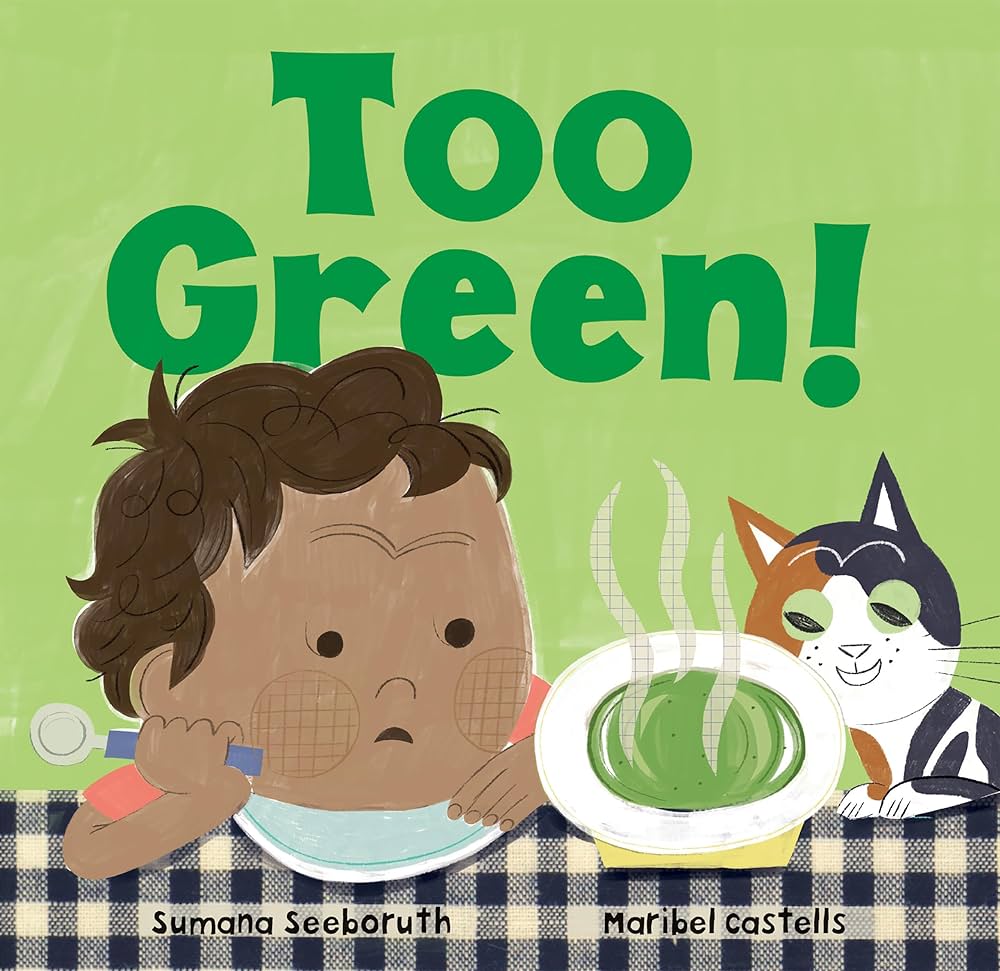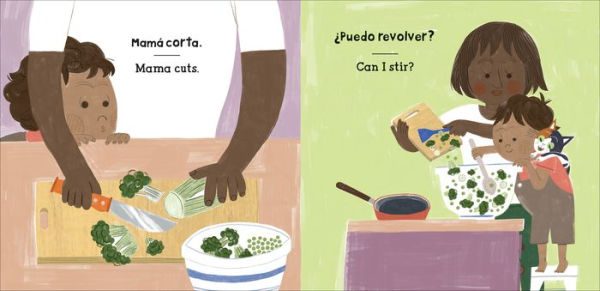
Inclusive Children's Book Teaching Guide
Too Green!
What is this book about?
In this Feelings & Firsts series board book, which features relatable rhyming text and diverse characters, we follow a reluctant young foodie as they help their Mum and Mama prepare a healthy green soup.
After carefully watching their parents enjoying the meal, the child finally agrees to taste it and discovers that he likes it too!
Through humor and sound effects, Too Green! offers a positive model for handling food reluctance while celebrating the courage to try new things and make healthy choices.
This bilingual board book is a 2024 Inclusive Books for Children (IBC) award winner.
Who is depicted in this book?
- A Rainbow family led by two moms
What early childhood themes and concepts does this book explore?
- Cooking routines and common words associated with cooking
- The five senses as they pertain to preparing and trying a new food
- Foods we like/dislike and what can happen if we try something new
- The color green
How does this book support anti-bias education?
This story of a Rainbow family preparing and sharing a meal depicts family pride and positive social identities.
Depending on how the book is shared or used—and the developmental level of the children—Too Green! may be used to support the following core goal from Anti-Bias Education for Young Children and Ourselves:
Identity—Teachers will nurture each child’s construction of knowledgeable and confident personal and social identities so that children will demonstrate self-awareness, confidence, family pride, and positive social identities.
How can this book be used to meet early childhood learning standards?
For all ages
Use Too Green! to meet early childhood literacy standards
For children from birth to age three
Teaching suggestion: Point out familiar settings and objects in the story and encourage the children to point at or name them. Observe and respond as they react to the illustrations.
What Illinois Early Learning Guideline does this meet for children from birth to age three?
Developmental DomainSocial-Emotional Development
Standard: Relationship with PeersChildren demonstrate the desire and develop the ability to engage and interact with other children.
Indicators for children:
- Begins to engage in parallel play, in closer proximity to other children but no interaction is attempted (7–18 months)
- Begins to engage in simple reciprocal interactions, e.g., rolling a ball back and forth (16–24 months)
- Demonstrates a preference for select peers (21–36 months)
Teaching suggestion: Model the parents' and child's actions and sounds as this kitchen-based story unfolds.
What Illinois Early Learning Guideline does this meet for children from birth to age three?
Developmental DomainLanguage Development, Communication and Literacy
Standard: Early LiteracyChildren demonstrate interest in and comprehension of printed materials.
Indicators for children:
- Imitates gestures and sounds during activities (7–18 months)
- Repeats familiar words in a book while being read to (16–24 months)
Teaching suggestion: Point to and name the family members in the story, using names that the children will recognize.
What Illinois Early Learning Guideline does this meet for children from birth to age three?
Developmental DomainLanguage Development, Communication and Literacy
Standard: Expressive CommunicationChildren demonstrate the ability to understand and convey thoughts through both nonverbal and verbal expression.
Indicators for children:
- Utters first words for familiar objects and people (7–18 months)
Teaching suggestion: Encourage the children to find the cat in the book's illustrations. Talk about and imitate the cat's responses to events as they unfold.
What Illinois Early Learning Guideline does this meet for children from birth to age three?
Developmental DomainCognitive Development
Standard: Concept DevelopmentChildren demonstrate the ability to connect pieces of information in understanding objects, ideas and relationships.
Indicators for children:
- Begins to identify characteristics of objects, e.g., “red ball” (16–24 months)
- Identifies characteristics of objects and people when named, e.g. colors (21–36 months)
- Identifies categories, e.g., able to point out all of the animals within a picture even with different types of objects represented (21–36 months)
Teaching suggestion: Identify and ask questions about the actions related to cooking depicted in the illustrations. Which ones are familiar to the children in your classroom?
What Illinois Early Learning Guideline does this meet for children from birth to age three?
Developmental DomainCognitive Development
Standard: Logic and ReasoningChildren demonstrate the ability to use knowledge, previous experiences, and trial and error to make sense of and impact their world.
Indicators for children:
- Imitates adult’s body language and simple actions, e.g., puts hands on hips or pretends to brush crumbs off table (7–18 months)
- Understands functionality of objects, e.g., mop is used to clean the floor (16–24 months)
- Makes a prediction of what will happen next in a sequence of events (24–36 months)
For preschoolers (ages three to five)
Teaching suggestion: Discuss the clues that help us understand what the child in the story likes and dislikes.
What Illinois Early Learning and Development Standards does this meet for preschoolers?
Language Arts Standard1ADemonstrate understanding through age-appropriate responses.
Benchmark 1.A.ECd:
Identify emotions from facial expressions and body language.
Social/Emotional Development Standard31ADevelop positive relationships with peers and adults.
Benchmark 31.A.ECb:
Recognize the feelings and perspectives of others.
Teaching suggestion: Encourage the children to describe what is happening in the illustrations as the family prepares the soup.
What Illinois Early Learning and Development Standards does this meet for preschoolers?
Language Arts Standard1EUse increasingly complex phrases, sentences and vocabulary.
Benchmark 1.E.ECa:
With teacher assistance, begin to use increasingly complex sentences.
Benchmark 1.E.ECb:
Exhibit curiosity and interest in learning new words heard in conversations and books.
Benchmark 1.E.ECd:
With teacher assistance, explore word relationships to understand the concepts represented by common categories of words (e.g., food, clothing, vehicles).
Teaching suggestion: Encourage the children to discuss foods that they like or dislike and share an example of a time when they tried a new food and liked it.
What Illinois Early Learning and Development Standards does this meet for preschoolers?
Social/Emotional Development Standard30BRecognize own uniqueness and personal qualities.
Benchmark 30.B.ECa:
Describe self using several basic characteristics.
Social/Emotional Development Standard30CDemonstrate skills related to successful personal and school outcomes.
Benchmark 30.C.ECa:
Exhibit eagerness and curiosity as a learner.
See inside this book.

